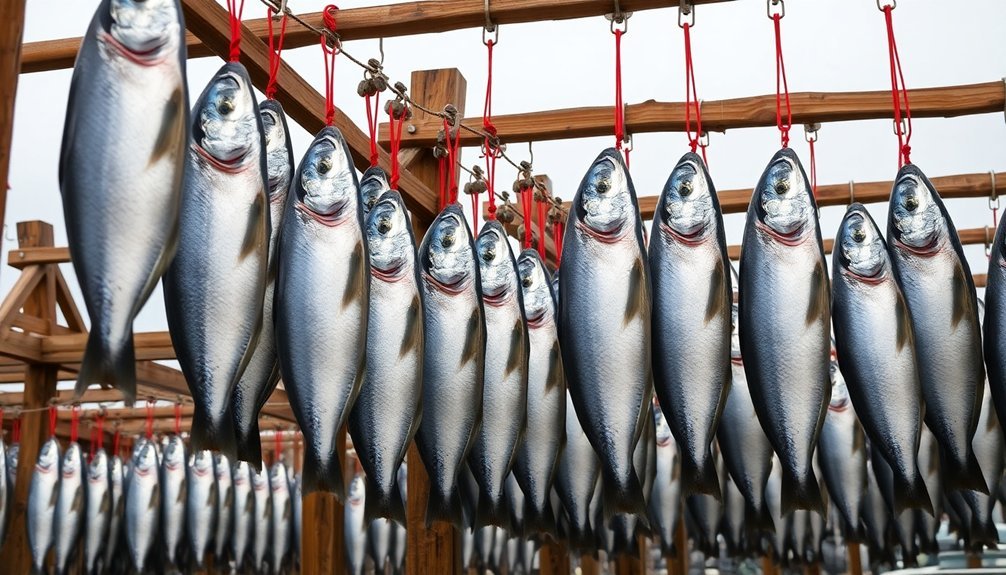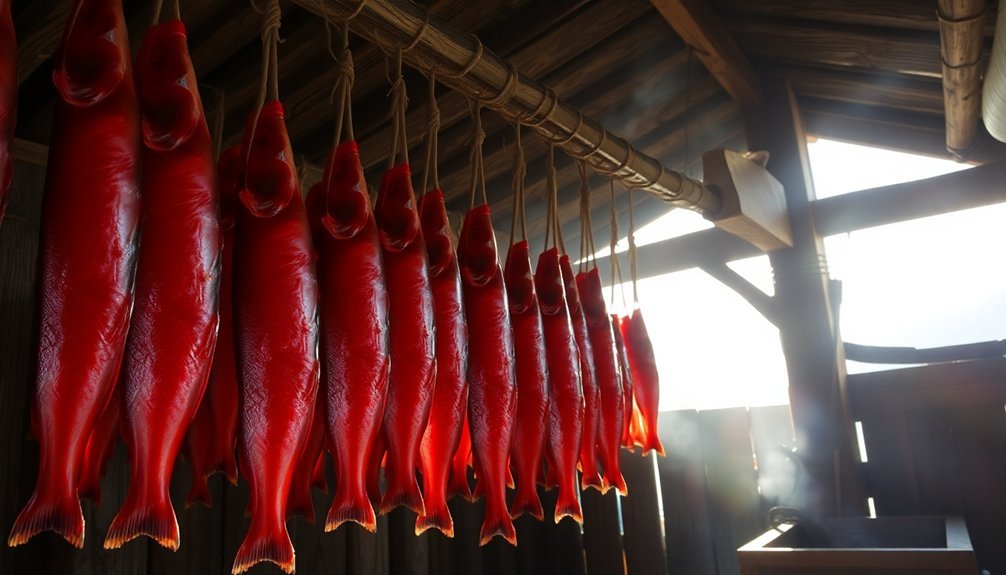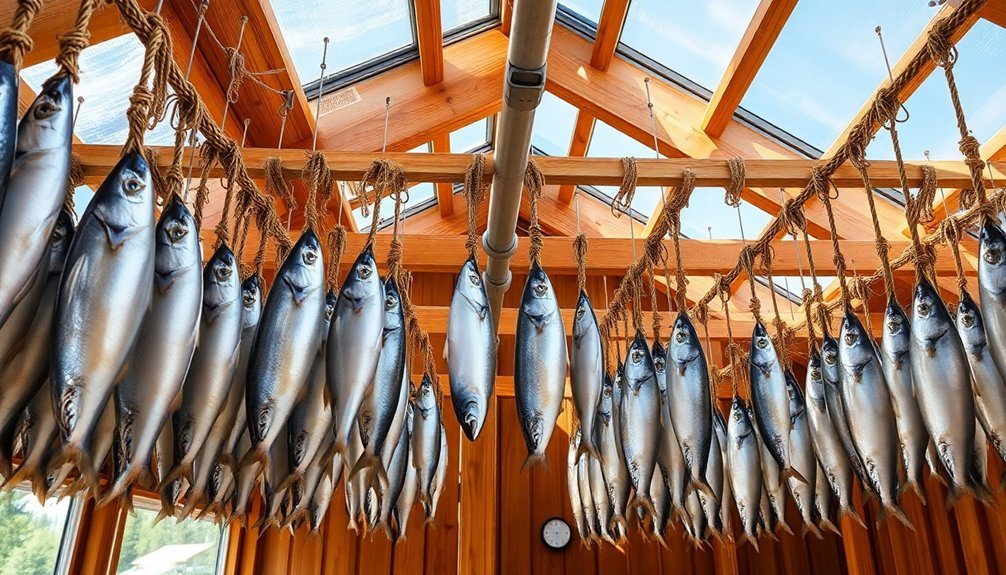Native fish drying connects you to ancient preservation wisdom that's sustained coastal communities for millennia. You'll want to start by gutting and scaling your catch, then applying salt to draw out moisture. Position your drying racks at least 1 meter high for ideal airflow, using sturdy materials like spruce poles and hardwood boards. Align your drying schedule with seasonal weather patterns – lower humidity and steady breezes work best. You can enhance preservation by combining salt curing with smoke exposure. These time-tested techniques transform fresh catches into nutrient-rich pantry staples, and there's so much more to discover about this sacred practice.
Ancient Coastal Fish Drying Practices

Along the ancient coastal regions, fish drying emerged as an essential preservation method that's still practiced today. You'll find this pharaonic craft deeply rooted in coastal communities, particularly around the Red Sea and Upper Egypt, where fishermen have relied on these techniques during extended fishing expeditions. The practice becomes especially significant during Ramadan and Eid celebrations.
When you're preparing fish for drying, you'll need to select large specimens like Harit and Raho. You'll start by gutting and scaling the fish, then carefully dissecting and removing the organs.
After washing the fish with sea water, you'll apply salt to both the inner cavity and outer surface, which helps draw out moisture and prevent bacterial growth.
The traditional process you'll follow involves letting the salted fish drain for one to three days. You'll then expose it to the sun for initial drying, wash off the salt mixture with sea water, and continue the drying process.
You'll need to place the fish on mats, sea sand, rocks, or rooftops where there's maximum sun exposure. Depending on the size, you're looking at a drying period of one to two months, with larger fish requiring more time.
Seasonal Timing and Weather Patterns
The timing of fish drying operations depends heavily on both seasonal fish migrations and local weather patterns. You'll need to coordinate your drying activities with the specific fish runs in your region, keeping in mind that different species arrive at different times throughout the year.
In Southeast Alaska, for example, you'll face challenges when silver salmon arrive during the wetter summer months. The region's high moisture levels require extra smoke and heat to properly dry the fish.
You must carefully monitor weather conditions to guarantee successful drying. When humidity rises above 75%, your fish will absorb moisture rather than release it, so you'll want to cut the fish thinner during damp weather to speed up the drying process.
Wind and sun exposure are vital factors – position your drying racks to maximize both. During rainy periods, you'll need to protect your fish or move them indoors.
Proper ventilation is essential throughout the process. You'll want to maintain a careful balance between smoke and fresh air in your smokehouse, using doors and vents to control airflow.
Remove nearby brush and grass to improve air circulation and reduce places where bears might hide. For storage, you'll need well-ventilated caches to prevent mold from developing.
Traditional Rack Building Techniques

When you're building a traditional fish-drying rack, you'll need to start with sturdy wooden or metal stands positioned on raised ground for proper air circulation.
You'll want to select durable materials like spruce poles for the cross-supports, as their rough surface helps prevent fish from slipping off during the drying process.
For maximum stability and function, you'll arrange the poles in a rectangular pattern with strong cross-bracing, ensuring the structure can withstand heavy loads of fish and challenging weather conditions.
Rack Height and Placement
Building effective fish drying racks requires careful attention to height and placement for ideal results. You'll want to raise your racks at least 1 meter off the ground to maximize air circulation, which speeds up the drying process and helps remove water trapped in fish gill cavities. The elevation allows air to flow from all directions – top, bottom, and sides.
| Consideration | Key Requirements |
|---|---|
| Location | Choose exposed areas with low humidity |
| Protection | Use tarpaulins for rain, nets for insects |
| Distance | Keep away from trees and waste areas |
| Structure | Maintain rectangular base for stability |
When selecting your rack's placement, you'll need to take into account both environmental and practical factors. Position your rack in an exposed area with good airflow, but make certain it's protected from rain and insects. You can use tarpaulins or plastic sheets for rain protection and mosquito nets to keep insects away. If you're in a fishing village that moves frequently, think about building a portable rack that's easy to assemble and disassemble. For split fish, you might want to create a sloping rack to help water drain from gut and gill cavities.
Material Selection for Durability
Selecting durable materials marks the foundation of any long-lasting fish drying rack. You'll want to start with hardwood boards for your base frame, as they resist heat, fungi, and insects effectively.
When arranging your foundation logs, verify they're equal in length and meet at a central point to create a stable rectangular pattern.
For vertical supports, you'll need to choose between metallic posts or wooden poles, setting them about 100 cm apart and burying them 60 cm deep for peak stability.
You can connect these posts using lighter wood pieces or bamboo at the top to create your frame structure.
To support your fish, you've got several reliable options: chicken wire, mosquito netting, or old fishing nets.
If you're using spruce poles, you'll benefit from their naturally rough surface that prevents fish from sliding.
Don't forget to secure your fish by their gill covers to the supporting material.
For protection against the elements, you'll need to incorporate tarps or plastic sheets to shield your catch from rain.
Adding protective netting keeps insects and other animals away from your drying fish, while verifying proper coverage during nights and rainy periods maintains the drying process's efficiency.
Cross-Support Design Patterns
Through generations of traditional knowledge, effective cross-support patterns have emerged as the backbone of fish drying rack construction.
Similar to rack-supported buildings, these structures maximize vertical space while maintaining stability for their specific purpose. You'll start by arranging logs of equal length to form your rack's base, ensuring they meet at a central point. Opposite logs should form straight lines, creating a rectangular foundation with clear corners marked by the log ends.
When you're building the rack structure, remember that stability is essential for holding multiple fish. You'll want to use spruce poles for the upper supports, as their rough texture prevents fish from sliding off. The design should allow you to hang fish in a way that maximizes their exposure to air while protecting them from predators like seagulls and ravens.
Your rack's raised design plays a critical role in the drying process. You'll achieve faster drying times by elevating the fish, which allows air to circulate freely around them from all directions.
This elevation also protects your catch from ground moisture and contamination. For additional protection, you can incorporate covers using tarps or netting, especially during rain or nighttime hours, while maintaining the essential airflow needed for proper drying.
Salt and Smoke Preservation
While traditional fish preservation methods vary across cultures, salt curing stands as one of the most effective and time-tested techniques. When you're preserving fish through salt curing, you'll need to understand how salt creates an inhospitable environment for bacteria by drawing moisture from the tissue.
You'll notice the process not only preserves the fish but also transforms its texture and enhances its flavor profile.
To successfully cure your fish, you'll want to completely submerge it in the brine that forms as the salt draws out moisture. You can use weights and planks to keep the fish submerged, and you'll need to check regularly to maintain proper salt concentration.
The process typically takes 2-3 weeks, during which you'll see the fish gradually transform.
For the best results, you'll want to focus on fatty fish species, as they respond particularly well to salt curing.
Once you've completed the process, store your cured fish in a cool, dark place at 2-4°C. If you've dried it properly to achieve klippfisk status (less than 48% water content), your preserved fish can last up to two years.
Sacred Methods Through Generations

You'll find ancient wisdom embedded in traditional fish drying methods, where indigenous communities have passed down sacred preservation techniques for countless generations.
The careful preparation and drying of fish often involves ceremonial rituals, from blessing the catch to positioning the racks according to ancestral customs.
These time-honored practices continue today, with tribal elders teaching younger members not just the technical aspects of drying fish, but also the spiritual significance that connects them to their ancestors.
Ancient Preservation Wisdom Lives
From the sun-baked shores of ancient Egypt to the windswept coasts of modern indigenous communities, traditional fish drying methods have remained remarkably unchanged for thousands of years.
You'll find evidence of these time-tested preservation techniques in archaeological sites worldwide, proving their effectiveness and universal appeal.
These ancient methods continue to thrive today because they work exceptionally well at preserving fish and enhancing its flavor.
You're witnessing living history when you observe these practices, which date back to the Stone Age and have been passed down through countless generations.
Here are the key preservation principles that have stood the test of time:
- Careful salting draws moisture from the fish, creating an inhospitable environment for harmful bacteria
- Strategic air-drying in well-ventilated areas guarantees proper moisture removal
- Natural preservatives like rosemary and thyme add antimicrobial protection
- Combined techniques of salting and drying maximize preservation effectiveness
- Size-specific methods guarantee ideal results for different fish varieties
Spiritual Drying Ceremonies Today
Steeped in centuries of tradition, Native American fish-drying ceremonies transcend mere preservation methods to become profound spiritual rituals. You'll find shamans and elders leading these sacred processes, where they honor the first salmon of the season using cedar bark mats, eagle down, and red ochre to symbolize peace and friendship.
As you observe these ceremonies, you'll notice women shamans carefully preparing the fish, bestowing honorary names upon the salmon while wearing ceremonial regalia. You won't see young people who've had recent contact with birth or puberty, as they're required to stay away to maintain the ceremony's purity.
When you participate in these rituals, you'll witness the community coming together to offer prayers of gratitude to both the fish and supernatural entities.
After the ceremonial feast, you'll see the careful gathering of bones, entrails, and uneaten parts, which are ceremonially burned. This disposal isn't just about cleanliness – it's believed to guarantee the salmon's revival and return, maintaining the delicate balance between people and nature.
These practices continue today, preserving ancient wisdom while strengthening community bonds.
Ocean Fish Storage Systems
Modern ocean fish storage systems rely on a combination of water-based holding facilities, ice cooling methods, and temperature-controlled environments to maintain freshness and quality.
You'll find that these systems play an essential role in preserving fish from the moment they're caught until they reach your table.
When storing live fish, you'll need clean water facilities with proper filtration, oxygen, and temperature controls.
It's important not to feed the fish during storage, as this helps extend their survival time by lowering their metabolic rate.
- You can use ice to cool large quantities of fish efficiently, requiring insulated containers to prevent melting.
- Temperature-controlled refrigeration keeps fish fresh at 0°C to 4°C.
- Freezing below -18°C stops bacterial growth completely.
- Storage containers need proper drainage systems for melting ice.
- ArcticStores and SuperStore cold rooms offer professional-grade storage solutions.
For the best results, you'll want to integrate these modern storage methods with traditional preservation techniques.
Combining salting, drying, or smoking with proper cold storage can notably extend your fish's shelf life while maintaining its quality.
Modern Adaptations of Native Methods

Today's adaptations of native fish drying methods blend time-tested traditions with cutting-edge technology. You'll find that while ancient practices like salting and air-drying remain foundational, they're now enhanced with sophisticated equipment and monitoring systems that guarantee consistency and food safety.
You can now combine traditional preprocessing techniques with modern innovations like ultrasound or plasma treatments to better preserve the fish's texture and nutritional content. These hybrid approaches maintain the essence of native methods while greatly reducing drying time and improving quality control.
For instance, you might start with traditional salting but then utilize heat pump technology or infrared drying to finish the process.
The most effective modern adaptations incorporate real-time monitoring systems that let you track moisture levels and adjust drying parameters instantly. You'll benefit from intelligent control systems that can automatically modify temperature and humidity based on the fish's condition.
Whether you're using sequential drying methods or simultaneous techniques, these technological integrations help prevent oxidation and preserve nutrients while maintaining the authentic characteristics that native methods are known for.
Frequently Asked Questions
How Do You Prevent Insects From Infesting Fish During the Drying Process?
You can protect drying fish by using mesh netting with good airflow, applying natural deterrents like chili and turmeric powder, maintaining controlled drying environments, and using approved chemical treatments when necessary.
What Determines the Ideal Thickness When Cutting Fish for Drying?
You'll want to cut your fish 1-2 inches thick to guarantee even drying. The thickness should allow air circulation while preventing the flesh from drying too quickly or remaining too moist inside.
Can Dried Fish Be Safely Consumed Without Rehydrating or Cooking First?
No, you shouldn't consume dried fish without rehydrating or cooking first. Due to potential chemical and microbial hazards, it's crucial to properly rehydrate and cook the fish to guarantee safe consumption and reduce health risks.
Which Fish Species Are Unsuitable for Traditional Air-Drying Methods?
You shouldn't air-dry fish like herring, mackerel, sole, or sardines. They've got either high moisture content, delicate flesh, or high lipid content that'll make traditional air-drying ineffective and potentially unsafe.
How Do Different Wood Types Affect the Flavor of Smoked Dried Fish?
You'll find that mild woods like alder enhance delicate fish, while stronger woods like hickory add bold smokiness. Fruitwoods offer sweet notes, and combining woods like apple-oak creates balanced flavors in your smoked fish.
In Summary
You'll find that these time-tested native fish drying methods remain significant in today's world. Whether you're using traditional cedar racks or modern adaptations, the core principles of proper timing, airflow, and sacred practices still produce excellent results. By connecting with these ancestral preservation techniques, you're not just storing fish – you're keeping alive a crucial cultural heritage that bridges past and present.





Leave a Reply